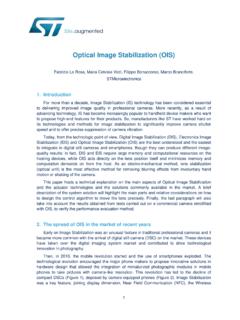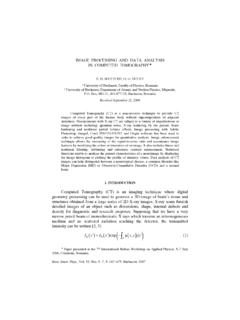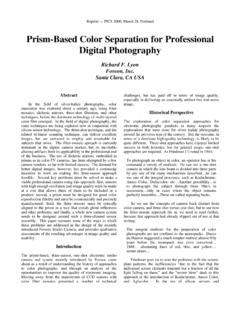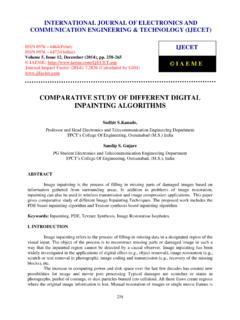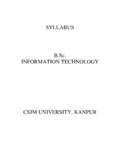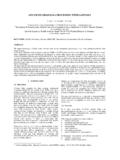Transcription of INTRODUCTION TO IMAGE PROCESSING - …
1 Readings in IMAGE PROCESSING OVERVIEW OF IMAGE PROCESSING Rao*,Deputy Director,NRSA,Hyderabad-500 037 INTRODUCTION IMAGE PROCESSING is a technique to enhance raw images received from cameras/sensors placed on satellites, space probes and aircrafts or pictures taken in normal day-to-day life for various applications. Various techniques have been developed in IMAGE PROCESSING during the last four to five decades. Most of the techniques are developed for enhancing images obtained from unmanned spacecrafts, space probes and military reconnaissance flights.
2 IMAGE PROCESSING systems are becoming popular due to easy availability of powerful personnel computers, large size memory devices, graphics softwares etc. IMAGE PROCESSING is used in various applications such as: Remote Sensing Medical Imaging Non-destructive Evaluation Forensic Studies Textiles Material Science. Military Film industry Document PROCESSING Graphic arts Printing Industry The common steps in IMAGE PROCESSING are IMAGE scanning, storing, enhancing and interpretation.
3 The schematic diagram of IMAGE scanner-digitizer diagram is shown in figure 1. Figure 1 * Deputy Director, National Remote Sensing Agency, Hyderabad, India. e-mail: Methods of IMAGE PROCESSING There are two methods available in IMAGE PROCESSING . Analog IMAGE PROCESSING Analog IMAGE PROCESSING refers to the alteration of IMAGE through electrical means. The most common example is the television IMAGE . The television signal is a voltage level which varies in amplitude to represent brightness through the IMAGE .
4 By electrically varying the signal, the displayed IMAGE appearance is altered. The brightness and contrast controls on a TV set serve to adjust the amplitude and reference of the video signal, resulting in the brightening, darkening and alteration of the brightness range of the displayed IMAGE . Digital IMAGE PROCESSING In this case, digital computers are used to process the IMAGE . The IMAGE will be converted to digital form using a scanner digitizer [6] (as shown in Figure 1) and then process it.
5 It is defined as the subjecting numerical representations of objects to a series of operations in order to obtain a desired result. It starts with one IMAGE and produces a modified version of the same. It is therefore a process that takes an IMAGE into another. The term digital IMAGE PROCESSING generally refers to PROCESSING of a two-dimensional picture by a digital computer [7,11]. In a broader context, it implies digital PROCESSING of any two-dimensional data.
6 A digital IMAGE is an array of real numbers represented by a finite number of bits. The principle advantage of Digital IMAGE PROCESSING methods is its versatility, repeatability and the preservation of original data precision. 1 Readings in IMAGE PROCESSING The various IMAGE PROCESSING techniques are: IMAGE representation IMAGE preprocessing IMAGE enhancement IMAGE restoration IMAGE analysis IMAGE reconstruction IMAGE data compression IMAGE Representation An IMAGE defined in the "real world" is considered to be a function of two real variables, for example, f(x,y) with f as the amplitude ( brightness) of the IMAGE at the real coordinate position (x,y).
7 The effect of digitization is shown in Figure 2. Figure 2 The 2D continuous IMAGE f(x,y) is divided into N rows and M columns. The intersection of a row and a column is called as pixel. The value assigned to the integer coordinates [m,n] with {m=0,1, 2,..,M-1} and {n=0,1,2,..,N-1} is f[m,n]. In fact, in most cases f(x,y)--which we might consider to be the physical signal that impinges on the face of a sensor. Typically an IMAGE file such as BMP, JPEG, TIFF etc.
8 , has some header and picture information. A header usually includes details like format identifier (typically first information), resolution, number of bits/pixel, compression type, etc. IMAGE Preprocessing Scaling The theme of the technique of magnification is to have a closer view by magnifying or zooming the interested part in the imagery. By reduction, we can bring the unmanageable size of data to a manageable limit.
9 For resampling an IMAGE Nearest Neighborhood, Linear, or cubic convolution techniques [5] are used. I. Magnification This is usually done to improve the scale of display for visual interpretation or sometimes to match the scale of one IMAGE to another. To magnify an IMAGE by a factor of 2, each pixel of the original IMAGE is replaced by a block of 2x2 pixels, all with the same brightness value as the original pixel. Figure 3 IMAGE Magnification II.
10 Reduction To reduce a digital IMAGE to the original data, every mth row and mth column of the original imagery is selected and displayed. Another way of accomplishing the same is by taking the average in 'm x m' block and displaying this average after proper rounding of the resultant value. 2 Readings in IMAGE PROCESSING Figure 4 IMAGE Reduction Rotation Rotation is used in IMAGE mosaic, IMAGE registration etc.
